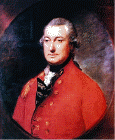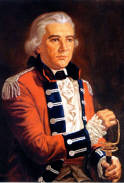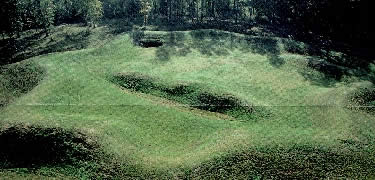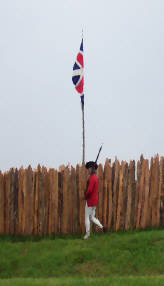THE AMERICAN
REVOLUTION
1775-1783
 The
events of the American Revolution in South Carolina followed
the experiences of a civil war, as closely as in any of the other
colonies. It pitted neighbour against neighbour, family against
family with a ferocity that led inevitably to the dispossession of
whoever would be unsuccessful in the struggle.
The
events of the American Revolution in South Carolina followed
the experiences of a civil war, as closely as in any of the other
colonies. It pitted neighbour against neighbour, family against
family with a ferocity that led inevitably to the dispossession of
whoever would be unsuccessful in the struggle.
In 1775 the first military force was raised for the defense of the
province. Commencement of hostilities by vessels of war had occurred
by November 12th. In 1775 most people in the South Carolina Upcountry
were reluctant to join the Revolution: at least that was the
assessment of Whig leaders in the Lowcountry, who sent astute
emissaries to the area in August. In general, the emissaries were
coolly received and by autumn lines were drawn. Each "side" suspected
the other of building an alliance with the feared Cherokees
just to the north and west. the Indians were afraid of settler
encroachment and so maintained a pro-British stance throughout the
war. Weeks of militia drills, confrontations and truce efforts
climaxed in November 1775: the Loyalists laid siege to a
hastily built fort near the settlement known as Ninety-Six.
The siege force was estimated to be at 2400 by the loyal militia
commander. After two days they overpowered the 600 defenders, but
then quickly agreed to a truce and dispersed.
 In
early 1776 the Whig Council of Safety sent in about 4000 troops, many
from North Carolina, against the Loyalists. On June 30th the
Cherokee, excited by the British, began their massacres on the
frontiers. (William Wallace stated that he fought with the
rebels against the Indians) "Soon after the attack by the British on
Charlestown in 1776, the Cherokees swarmed into the northern
settlements, scalping men, women, and children, and burning the
cabins of settlers. The South Carolina Militia, plus militia from
Georgia, North Carolina and Virginia, moved against them and
devastated their territory so completely that many died of
starvation."
In
early 1776 the Whig Council of Safety sent in about 4000 troops, many
from North Carolina, against the Loyalists. On June 30th the
Cherokee, excited by the British, began their massacres on the
frontiers. (William Wallace stated that he fought with the
rebels against the Indians) "Soon after the attack by the British on
Charlestown in 1776, the Cherokees swarmed into the northern
settlements, scalping men, women, and children, and burning the
cabins of settlers. The South Carolina Militia, plus militia from
Georgia, North Carolina and Virginia, moved against them and
devastated their territory so completely that many died of
starvation."
The British Governor of South Carolina, Sir Henry Clinton,
in 1780, after the surrender of Charlestown
on May 12th,proclaimed that all South Carolina men must take
an oath of allegiance or be treated as rebels. This brought about mob
violence among rebels against those of opposing views. Those with
loyalist leanings however, thought that the British would win the
war. Many, 810, joined under Bryan and headed for Lord
Cornwallis' army. Cornwallis had taken command of the southern
department with 4,000 troops. The loyalist militia met them at
Augusta, Camden
and Ninety - Six.
 "The
defeat of the Patriots (Rebels or Whigs) at Camden by
Cornwallis' army unleashed bands of Tories (Loyalists) thirsting for
revenge against Whigs who had earlier plundered their homes and farms
and in some cases had tarred and feathered them. One hundred and
thirty-seven (1337) battles and minor engagements took place. British
commander Major Patrick Ferguson threatened the over-mountain
men that, if they supported the enemies of the king, he would march
over the mountains, "hang their leaders and lay their country waste
with fire and sword!"
"The
defeat of the Patriots (Rebels or Whigs) at Camden by
Cornwallis' army unleashed bands of Tories (Loyalists) thirsting for
revenge against Whigs who had earlier plundered their homes and farms
and in some cases had tarred and feathered them. One hundred and
thirty-seven (1337) battles and minor engagements took place. British
commander Major Patrick Ferguson threatened the over-mountain
men that, if they supported the enemies of the king, he would march
over the mountains, "hang their leaders and lay their country waste
with fire and sword!"
Most of Ferguson's men were volunteers, militiamen. Some
like Rueben Lively, had previously served with the
revolutionary militia. He succeeded in shaping the men of the 96th
district into a respectable brigade of eight regiments.
Ferguson understood backcountrymen better than did any of his
British comrades, quickly identifying the danger that the British
would make their presence felt too strongly: he saw the need to
proceed without either "dampening the zeal of our friends' or
"exasperating those rebels who are quietly disposed. He led them well
and they fought well. Unfortunately he got many of them, and himself,
killed at King's Mountain. The British
Army used the militia extensively for non-combat functions. they
were foragers, scouts, messengers, spies or used for waggoning,
hauling, digging or cattle driving. These skills would come handy as
British fortunes took a turn for the worse. Living in the stockade at
Ninety-six was prudent, and even necessary, as more and more houses
were pillaged and burned on both sides.
At the Battle of Cowpens in January
1781, the British Legion and the royal forces were overwhelmingly
defeated. The British were becoming discouraged. Without adequate
provisions, the army had campaigned " in the most barren
inhospitable, unhealthy part" of the southern backcountry, and had
opposed " the most savage, inveterate, perfidious, cruel enemy, with
zeal and with bayonets only." following another unsuccessful major
engagement at Guilford Court House on 15 March
1781, Cornwallis surprisingly turned away from the Carolinas, and
marched his exhausted and frustrated troops towards Virginia
and Yorktown. Thus, the southern strategy was terminated and the
loyal Americans of the South were abandoned.
 Cornwallis
had by May 10th completed the evacuation of Camden. This left
the British garrison at Fort
Ninety-Six left alone in the South Carolina Back Country. The
fort was garrisoned by elements of DeLancey's Brigade and the
New Jersey Volunteers. (William Wallace was probably in
this fort) "On learning that General Nathaniel Greene was
marching toward 96, John H. Cruger (the British commander of the
fort, Advised the South Carolina Militia to escape on horseback to
Charlestown. There was not enough food to feed so big a garrison
during a long siege, and the known bitter enmity of the anti-British
southerners to their Loyalist neighbours would complicate matters,
should the fort surrender. Colonel King and his men (one being
William Wallace), however, proudly refused to leave what they
considered a pact of duty. Instead, they turned their excellent
horses into the weeds and remained to support the garrison and await
the trial of battle. The British fort at 96 was garrisoned by 550
men, with adequate ammunition and food, but a makeshift water supply.
"
Cornwallis
had by May 10th completed the evacuation of Camden. This left
the British garrison at Fort
Ninety-Six left alone in the South Carolina Back Country. The
fort was garrisoned by elements of DeLancey's Brigade and the
New Jersey Volunteers. (William Wallace was probably in
this fort) "On learning that General Nathaniel Greene was
marching toward 96, John H. Cruger (the British commander of the
fort, Advised the South Carolina Militia to escape on horseback to
Charlestown. There was not enough food to feed so big a garrison
during a long siege, and the known bitter enmity of the anti-British
southerners to their Loyalist neighbours would complicate matters,
should the fort surrender. Colonel King and his men (one being
William Wallace), however, proudly refused to leave what they
considered a pact of duty. Instead, they turned their excellent
horses into the weeds and remained to support the garrison and await
the trial of battle. The British fort at 96 was garrisoned by 550
men, with adequate ammunition and food, but a makeshift water supply.
"

"Lt. Colonel. John Harris Cruger of New York, had fortified
the village with a stockade and an eight foot ditch. On high ground
at the village's eastern edge, he constructed an eight-pointed
star redoubt, with cannon mounted on the
redoubt. The assault began on May 24th. Theirs was a desperate
defense, for the killing, rape, house burning and plunder on both
sides called for revenge. News reached Greene during his assault at
Ninety-Six that the twenty-six year old Lord Rawdon was
advancing from Charlestown to relieve Ninety-Six."
 The
British held out for a total of 28 days in May and June, 1781,
against the siege by General Nathaniel Greene and his
Continental Army. The Americans started a military mine to blow up
Star Fort, but the news of the British reinforcements under Lord
Rawdon marching to aid the garrison, forced General Greene to
withdraw before superior numbers. Lord Rawdon arrived two days after
Greene left and felt he could not hold the fort with all of the other
outposts in rebel hands, so Cruger evacuated the fort and followed
Rawdon back to Charlestown.
The
British held out for a total of 28 days in May and June, 1781,
against the siege by General Nathaniel Greene and his
Continental Army. The Americans started a military mine to blow up
Star Fort, but the news of the British reinforcements under Lord
Rawdon marching to aid the garrison, forced General Greene to
withdraw before superior numbers. Lord Rawdon arrived two days after
Greene left and felt he could not hold the fort with all of the other
outposts in rebel hands, so Cruger evacuated the fort and followed
Rawdon back to Charlestown.
 After
September of 1781, the British and Loyalist in the south were
virtually confined to Savannah, Charlestown, and other ports.
After a brief stop at Orangeburgh, the evacuees of Ninety-Six
joined the hordes that were gathering in the Charlestown area:
Loyalists from both Carolinas, slaves of questionable ownership, and
blacks who had fled from their revolutionary owners to the British
promise of freedom. Fifteen months would pass before the British
evacuated the city.
After
September of 1781, the British and Loyalist in the south were
virtually confined to Savannah, Charlestown, and other ports.
After a brief stop at Orangeburgh, the evacuees of Ninety-Six
joined the hordes that were gathering in the Charlestown area:
Loyalists from both Carolinas, slaves of questionable ownership, and
blacks who had fled from their revolutionary owners to the British
promise of freedom. Fifteen months would pass before the British
evacuated the city.
The Loyal families from Ninety-six and Camden, were cruelly
neglected. From the 96th district there were 48 men, 75 women, 259
children. They built huts outside the lines of fortification in a
settlement called, "Rawdon Town", which became a term of
reproach because of its poverty and wretchedness. Some lived on
Johns or James Island, or lucky ones in houses on Church St.
The hunger and the misery are reflected in British records of the
distribution of food, clothing, tents , camp equipment and cash to
several hundred refugees during the winter of 1781-82. There were
lotteries for refugee relief. A school for refugee children operated
in November, December and January 1781-1782 and again in May, June
and July of 1782. Henry Martindale, later a neighbour of
William Wallace's, was on the school committee. The relief measures
were inadequate. The six men practicing medicine at government
expense could do little more than distribute palliatives: camphor,
extract of saturn, gall stomach bitters, a little sugar and wine, and
a great deal of tea. One hundred and sixty-three refugees were buried
at public expense: they died largely from colds in late winter and
fevers in late summer. James Donaldson of Charleston, S.C. received
an order to provide a coffin for the child of refugee, William
Wallace on August 28, 1782.
 One
possibility for the refugees awaiting evacuation was to return to
their homes and face the enmity of their neighbours. Few Upcountrymen
were named in the 1782 confiscation and banishment legislation, their
turn would come in the confiscation ordinance of 1783 -- so return
was at least a legal possibility throughout 1782. The British
commander encouraged militiamen and other refugees to return home. At
least 1000 civilian men and women were given payments at this time,
typically a guinea each to buy a horse with which to return to the
backcountry. Some refugees did return. For those persons who did not
return to their homes, army transport ships would take them to
Jamaica, East Florida, Britain, Nova
Scotia, New York and St. Lucia. In general, the
islands attracted men with slaves: families went with the army to
Halifax and New York: and East Florida claimed a cross-section of
slave holders and non-slave holders, single men and families. The
nucleus of the Rawdon settlement were among the 501 who boarded the
transports for Halifax. Almost all the other Rawdon settlers chose
nearby East Florida, with its familiar climate and relative ease of
return to the backcountry. After almost tow years in East Florida,
they faced new migration choices and the British evacuated both
Floridas in keeping with their 1783 cession to Spain. Between April
1784 and November 1785, transports took civilian East Floridians to
Britain, Nova Scotia, Jamaica, Dominica, the Bahamas and the Mosquito
Coast. Those who go go to Rawdon directly upon their arrival
in Nova Scotia in 1784, boarded the first transports to
go to Nova Scotia, less than two months after the evacuation began in
the spring of 1784.
One
possibility for the refugees awaiting evacuation was to return to
their homes and face the enmity of their neighbours. Few Upcountrymen
were named in the 1782 confiscation and banishment legislation, their
turn would come in the confiscation ordinance of 1783 -- so return
was at least a legal possibility throughout 1782. The British
commander encouraged militiamen and other refugees to return home. At
least 1000 civilian men and women were given payments at this time,
typically a guinea each to buy a horse with which to return to the
backcountry. Some refugees did return. For those persons who did not
return to their homes, army transport ships would take them to
Jamaica, East Florida, Britain, Nova
Scotia, New York and St. Lucia. In general, the
islands attracted men with slaves: families went with the army to
Halifax and New York: and East Florida claimed a cross-section of
slave holders and non-slave holders, single men and families. The
nucleus of the Rawdon settlement were among the 501 who boarded the
transports for Halifax. Almost all the other Rawdon settlers chose
nearby East Florida, with its familiar climate and relative ease of
return to the backcountry. After almost tow years in East Florida,
they faced new migration choices and the British evacuated both
Floridas in keeping with their 1783 cession to Spain. Between April
1784 and November 1785, transports took civilian East Floridians to
Britain, Nova Scotia, Jamaica, Dominica, the Bahamas and the Mosquito
Coast. Those who go go to Rawdon directly upon their arrival
in Nova Scotia in 1784, boarded the first transports to
go to Nova Scotia, less than two months after the evacuation began in
the spring of 1784.
SOURCES:
Allen, Robert S. The Loyal Americans. Ottawa: National Museums
of Canada, 1983.
Lefton, Gwen. The Wallace Family. Halifax. 1999.
Carole Troxler " Loyalist Refugees and the
British Evacuation of East Florida, 1783-1785", Florida Historical
Quarterly (July 1981), 1-28.
Carole Troxler " Origins of the Rawdon Loyalist Settlement",
Nova Scotia Historical Review (1988) 63-76.
"THE WINNING OF INDEPENDENCE,
1777-1783" AMERICAN MILITARY
HISTORY,ARMY HISTORICAL
SERIES. OFFICE OF THE CHIEF OF MILITARY
HISTORY UNITED STATES ARMY
PRIMARY SOURCES
Queen Charlotte on the
American Revolution
W.
Wardlaw to A. Wm.son. LONG CANE, December 7, 2 o'clock, P. M.,
1778.
Journal
of the Siege of Charleston by the English in 1780. The Army Commanded
by Gen. Sir Henry Clinton, and the Fleet by Admiral Arbuthnot. The
Garrison by Major-General Lincoln.
Copy
of a letter from Colonel Sumpter to General Gate, dated Wateree
ferry, August 15th 1780.
Extract
of a letter from General Gates to the President of Congress, dated
Hillsborough, Aug. 20, 1780
List
of the continental officers killed, captivated, wounded, and missing,
in the actions of the 16th and 18th of
August, 1780.
General
Morgan to General Greene-Report on the Battle of Cowpens Camp on
Cain Creek on Pedee January 19th, 1781.
N.
Balfour to the Militia prisoners of War CHARLESTON, May 17,
1781.
Lieut.
Col. Thomas Brown to Brig. Gen. Pickens and Lieut. Col. Lee May 31,
1781
Brig.
Gen. Pickens and Henry Lee, jr. to Lieut. Col. Brown HEAD
QUARTERS, June 4, 1781.
Lieut.
Col. Brown to Brig. Gen. Pickens and L't. Col. Lee, June 4,
1781
Lord
Rawdon to Lieut. Gen. Cornwallis CHARLES TOWN, June 5,
1781.
Lieut.
Col. Brown to Brig. Gen. Pickens and Lieut. Col. Lee, jr. FORT
CORNWALLIS, June 5, 1781.
Treaty
between Gen'l. Marion in behalf of the State of South Carolina, and
Major Ganey and the inhabitants under his commands which were
included in the treaty made the 17th June, 1781 (as above mentioned)
with Major Ganey.
Gen.
Greene to Lieut. Col. Lee June 25,
1781.
Gen.
Greene to Gen. Marion HEAD QUARTERS NEAR SANDY RIVER, June 25,
1781.
Extract
of a Letter from Ad'jt. Gen. Williams to Maj. Pendleton, Aid-de-Camp
to Genl. Greene CAMP HILLS, SANTEE, July 16,
1781.
PROCLAMATION-STATE
OF SOUTH CAROLINA September 1781
Copy
of the articles of capitulation October
1781
Copy
of Earl Cornwallis' letter to General Washington, dated York, in
Virginia, 18th October,
1781.
You are life form number
to access this page since January 15, 2005
 Drop
us a line!
Drop
us a line!
 The
events of the American Revolution in South Carolina followed
the experiences of a civil war, as closely as in any of the other
colonies. It pitted neighbour against neighbour, family against
family with a ferocity that led inevitably to the dispossession of
whoever would be unsuccessful in the struggle.
The
events of the American Revolution in South Carolina followed
the experiences of a civil war, as closely as in any of the other
colonies. It pitted neighbour against neighbour, family against
family with a ferocity that led inevitably to the dispossession of
whoever would be unsuccessful in the struggle. In
early 1776 the Whig Council of Safety sent in about 4000 troops, many
from North Carolina, against the Loyalists. On June 30th the
Cherokee, excited by the British, began their massacres on the
frontiers. (William Wallace stated that he fought with the
rebels against the Indians) "Soon after the attack by the British on
Charlestown in 1776, the Cherokees swarmed into the
In
early 1776 the Whig Council of Safety sent in about 4000 troops, many
from North Carolina, against the Loyalists. On June 30th the
Cherokee, excited by the British, began their massacres on the
frontiers. (William Wallace stated that he fought with the
rebels against the Indians) "Soon after the attack by the British on
Charlestown in 1776, the Cherokees swarmed into the  "The
defeat of the Patriots (Rebels or Whigs) at Camden by
Cornwallis' army unleashed bands of Tories (Loyalists) thirsting for
revenge against Whigs who had earlier plundered their homes and farms
and in some cases had tarred and feathered them. One hundred and
thirty-seven (1337) battles and minor engagements took place. British
commander Major Patrick Ferguson threatened the over-mountain
men that, if they supported the enemies of the king, he would march
over the mountains, "hang their leaders and lay their country waste
with fire and sword!"
"The
defeat of the Patriots (Rebels or Whigs) at Camden by
Cornwallis' army unleashed bands of Tories (Loyalists) thirsting for
revenge against Whigs who had earlier plundered their homes and farms
and in some cases had tarred and feathered them. One hundred and
thirty-seven (1337) battles and minor engagements took place. British
commander Major Patrick Ferguson threatened the over-mountain
men that, if they supported the enemies of the king, he would march
over the mountains, "hang their leaders and lay their country waste
with fire and sword!" Cornwallis
had by May 10th completed the evacuation of Camden. This left
the British garrison at
Cornwallis
had by May 10th completed the evacuation of Camden. This left
the British garrison at 
 The
British held out for a total of 28 days in May and June, 1781,
against the siege by General Nathaniel Greene and his
Continental Army. The Americans started a military mine to blow up
Star Fort, but the news of the British reinforcements under Lord
Rawdon marching to aid the garrison, forced General Greene to
withdraw before superior numbers. Lord Rawdon arrived two days after
Greene left and felt he could not hold the fort with all of the other
outposts in rebel hands, so Cruger evacuated the fort and followed
Rawdon back to Charlestown.
The
British held out for a total of 28 days in May and June, 1781,
against the siege by General Nathaniel Greene and his
Continental Army. The Americans started a military mine to blow up
Star Fort, but the news of the British reinforcements under Lord
Rawdon marching to aid the garrison, forced General Greene to
withdraw before superior numbers. Lord Rawdon arrived two days after
Greene left and felt he could not hold the fort with all of the other
outposts in rebel hands, so Cruger evacuated the fort and followed
Rawdon back to Charlestown. After
September of 1781, the British and Loyalist in the south were
virtually confined to Savannah, Charlestown, and other ports.
After a brief stop at Orangeburgh, the evacuees of Ninety-Six
joined the hordes that were gathering in the Charlestown area:
Loyalists from both Carolinas, slaves of questionable ownership, and
blacks who had fled from their revolutionary owners to the British
promise of freedom. Fifteen months would pass before the British
evacuated the city.
After
September of 1781, the British and Loyalist in the south were
virtually confined to Savannah, Charlestown, and other ports.
After a brief stop at Orangeburgh, the evacuees of Ninety-Six
joined the hordes that were gathering in the Charlestown area:
Loyalists from both Carolinas, slaves of questionable ownership, and
blacks who had fled from their revolutionary owners to the British
promise of freedom. Fifteen months would pass before the British
evacuated the city. Drop
us a line!
Drop
us a line!